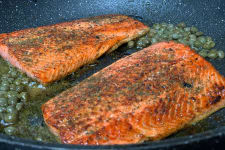
Benefits of Salmon for Working Out
April 5th, 2024How Eating Salmon Can Optimize Your Workout
When it comes to eating for exercise, salmon stands out as a top food1 for bodybuilding diets. That’s because wild-caught salmon contains protein, omega-3 fatty acids, and essential amino acids that provide high-quality fuel.
Among the plethora of protein options out there, wild salmon is one of the best foods for building muscle. In fact, many athletes swear by it. But salmon also plays an important part in workout recovery, endurance, and injury prevention. If you’ve been looking for real, whole food options to integrate into your workout regimen then check out what wild salmon can do for you.
Salmon for Muscle Building
Salmon is rich in high-quality protein — a key component of muscle repair and growth. The nutrient-dense protein of wild salmon is low in saturated fat and incorporates benefits that other protein sources lack. Post-workout tissue repairs that synthesize high-quality forms of protein, allow you to achieve greater strength and endurance over time.
Amino acids, the building blocks of protein2, are essential for repairing and rebuilding muscle tissues. Providing a complete array of amino acids, salmon includes essential ones like leucine. Leucine stimulates muscle protein synthesis and facilitates muscle repair5. By adding salmon into your diet, you ensure that your muscles receive the necessary amino acids to optimize growth and accelerate recovery.
What’s more, the omega-3 fatty acids found in wild-caught salmon (EPA and DHA) contribute significantly to muscle repair and growth. By promoting efficient nutrient delivery to muscle cells, omega-3s support the synthesis of new muscle tissue, aiding in the development of lean muscle mass. You’ll enjoy a speedier recovery, ensuring you can bounce back stronger for your next training session.
Boosting Endurance and Energy Levels
Fitness benefits of salmon are many. And as you’ve seen, omega-3s fatty acids play a lot of roles — and there’s more. These types of fat in salmon also support healthy heart function, promoting efficient blood flow and oxygen delivery to working muscles. Enhanced circulation ensures that your muscles receive the oxygen and nutrients they need to perform at their peak. This allows you to push through intense workouts more easily, as it can help delay the onset of fatigue.
You can’t talk about cellular energy without mentioning mitochondria. Mitochondria are the energy workhorses of our cells. When they get damaged, it lowers our overall energy level3. Luckily, omega-3s in salmon also support mitochondrial function and promote a strong anti-inflammatory response. By optimizing mitochondrial efficiency, salmon helps your body produce energy more effectively. This provides a sustained fuel source, enabling you to maintain high-performance levels.
Salmon’s healthy fats, specifically EPA and DHA, also play a role in how efficiently your body uses oxygen. These nutrients support healthy cardiovascular function, helping to deliver oxygen to tissues, muscles, and organs4.
Recovery and Injury Prevention
The high protein content in wild salmon supports tissue repair for rebuilding muscles after intense workouts. Further, the vitamin D in salmon contributes to bone health by supporting calcium uptake and bone development6. Strong healthy bones reduce the risk of injuries. Consuming these nutrients regularly can aid in recovery and help protect your body against fractures.
EPA and DHA in salmon may support quick muscle recovery and alleviate soreness.
Incorporating Salmon Into Your Fitness Regimen
So, how do you incorporate salmon into your fitness regimen? It's easy! To reap its full benefits, aim to include salmon in your diet at least two to three times a week. Opt for healthier cooking methods such as baking, pan-searing, or grilling. But try to avoid panko breading and deep frying most of the time. Consider pairing fish with complex carbohydrates and leafy greens for a well-rounded meal that fuels your body for peak performance.
Frequently Asked Questions (FAQs)
1. How much salmon should I consume for fitness benefits?
For fitness benefits, aim for 2 to 3, 3 oz. servings of salmon weekly, providing ample protein
and omega-3s.
2. How does cooking method affect the nutritional value of salmon?
Grilling, baking, or steaming preserves salmon's nutrients better than frying,
maintaining its health benefits.
3. Are there any specific types of salmon that offer greater benefits?
Wild-caught salmon typically offers superior benefits due to its higher omega-3
content and fewer contaminants.
4. How do I ensure I'm purchasing high-quality salmon?
Ensure high-quality salmon by opting for wild-caught varieties sourced from sustainable fisheries, such as the tightly managed fisheries in Alaska. Buy wild-caught salmon today to start optimizing your workouts and workout recovery.





